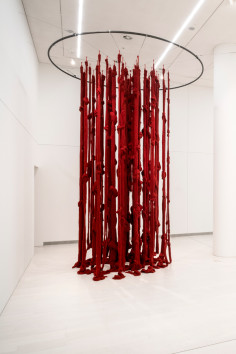Cecilia Vicuña
Quipu Womb

source: documenta14de
Although better known as a poet in her adoptive North American home (she has lived in New York since the 1980s), Cecilia Vicuña has stayed true to her youthful calling as a genre-bending visual artist for more than forty years, and her site-specific projects highlight the artist’s talent for composing poems in space, for a visceral lyricism in three dimensions. Vicuña refers to these particular works as “quipoems”—a contraction of poem and quipu; an online dictionary defines quipu, rather reductively, as “a device consisting of a cord with knotted strings of various colors attached, used by the ancient Peruvians for recording events, keeping accounts, etc.” A pre-Columbian type of writing, in other, more poetical words—product of a literary tradition that has given the world such luminaries as Gabriela Mistral, Pablo Neruda, and Nicanor Parra. Vicuña, who was born in 1948 in Santiago de Chile, is supremely aware of the weight of Indigenous history anchoring twentieth-century Latin American culture.
Blown up to the monumental proportions of immersive “soft sculpture,” her recent Athenian quipoem consists of giant strands of untreated wool, sourced from a local Greek provider, dyed a startling crimson in honor of a syncretic religious tradition that, via the umbilical cord of menstrual symbolism, connects Andean mother goddesses with the maritime mythologies of ancient Greece.
Her early figurative paintings made in the early 1970s juxtapose portraits of female poets (including Mistral) with a phalanx of male political heroes such as Karl Marx, Vladimir Lenin, Fidel Castro, and Chile’s very own Salvador Allende—though their steadfast masculinity appears deliciously corrupted by Vicuña’s trademark Pop-painterly touch, as evinced in the halolike garland of flowers surrounding Marx’s head or the curious genital imagery peopling the surreal landscape against which Lenin is portrayed. Painted in 1972, these portraits now look like melancholy mementos of a utopian moment cut short: a year later, a CIA-supported and Pinochet-led military coup spelled the bloody end of Allende’s socialist experiment, forcing the artist into a state of exile—first to London, then Colombia, then New York—from which she has never really returned.
.
.
.
.
.
.
.
source: documenta14de
Αν και στη Βόρεια Αµερική όπου έχει επιλέξει να ζει (εγκαταστάθηκε στη Νέα Υόρκη τη δεκαετία του ’80) είναι περισσότερο γνωστή ως ποιήτρια, η Cecilia Vicuña παραµένει επί 40 και πλέον χρόνια πιστή στη νεανική της κλίση ως ανένταχτης εικαστικής καλλιτέχνιδας· τα έργα της για συγκεκριµένο χώρο (site-specific) αναδεικνύουν το ταλέντο της να συνθέτει ποιήµατα στον χώρο και να εκφράζεται µ’ έναν ενστικτώδη λυρισµό που απλώνεται σε τρεις διαστάσεις. Η Vicuña αναφέρεται σε αυτά τα έργα ως «quipoems» – σύνθεση από την αγγλική λέξη poem (ποίηµα) και τη λέξη quipu· σ’ ένα λεξικό στο διαδίκτυο η λέξη quipu ορίζεται ως «ένα αντικείµενο που αποτελείται από ένα κορδόνι όπου επάνω του είναι στερεωµένα νήµατα διάφορων χρωµάτων µε κόµπους, το οποίο το χρησιµοποιούσαν στην αρχαιότητα οι Περουβιανοί για να καταγράφουν γεγονότα, να κάνουν λογαριασµούς κ.τ.λ.». Με άλλα λόγια λοιπόν, πρόκειται για έναν τρόπο γραφής της προκολοµβιανής εποχής – προϊόν µιας λογοτεχνικής παράδοσης που χάρισε στον κόσµο τόσο φωτεινά µυαλά όπως η Gabriela Mistral, ο Pablo Neruda και ο Nicanor Para. Η Vicuña, που γεννήθηκε το 1948 στο Σαντιάγκο της Χιλής, έχει πλήρη επίγνωση του βάρους της αυτόχθονης ιστορίας που συνδέεται µε τη λατινοαµερικανική κουλτούρα του 20ού αιώνα.
Το πρόσφατο quipoem για την Αθήνα, σε µνηµειώδεις διαστάσεις «µαλακής γλυπτικής», αποτελείται από τεράστιες λωρίδες ακατέργαστου µαλλιού, που η Vicuña πήρε από έναν ντόπιο προµηθευτή, βαµµένες σ’ ένα εντυπωσιακό άλικο χρώµα προς τιµήν µιας συγκρητικής θρησκευτικής παράδοσης η οποία, µε οµφάλιο λώρο τον συµβολισµό της εµµηνόρροιας, συνδέει τις µητρικές θεότητες των Άνδεων µε τη θαλάσσια µυθολογία της αρχαίας Ελλάδας.
Στην πρώιµη παραστατική ζωγραφική της των αρχών της δεκαετίας του ’70 η Vicuña αντιπαραβάλλει ποιήτριες (συµπεριλαµβανοµένης της Mistral) µε πλήθος αντρών που υπήρξαν πολιτικοί ήρωες, όπως ο Karl Marx, ο Vladimir Lenin, ο Fidel Castro και ο ήρωας της Χιλής Salvador Allende – αν και η έντονη αρρεvωπότητά τους µοιάζει χιουµοριστικά αλλοιωµένη από το ποπ εικαστικό ύφος της Vicuña, όπως µαρτυρούν η γιρλάντα από λουλούδια που περιβάλλει σαν φωτοστέφανο το κεφάλι του Marx ή οι περίεργες απεικονίσεις γεννητικών οργάνων που κοσµούν το σουρεαλιστικό τοπίο µέσα στο οποίο η ζωγράφος προσωπογραφεί τον Lenin. Αυτά τα πορτρέτα, που φιλοτεχνήθηκαν το 1972, σήµερα µοιάζουν µε µελαγχολικά ενθύµια µιας ουτοπικής στιγµής που διακόπηκε ξαφνικά: ύστερα από έναν χρόνο, το στρατιωτικό πραξικόπηµα του Pinochet που υποστηρίχθηκε από τη CIA έπνιξε στο αίµα το σοσιαλιστικό πείραµα του Allende, αναγκάζοντας τη δηµιουργό να βρεθεί εξόριστη – αρχικά στο Λονδίνο, κατόπιν στην Κολοµβία κι έπειτα στη Νέα Υόρκη, απ’ όπου δεν επέστρεψε ουσιαστικά ποτέ.

